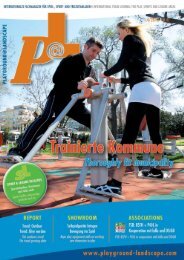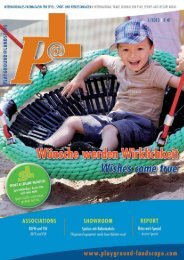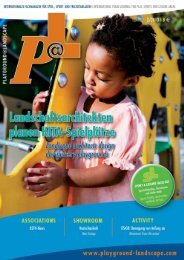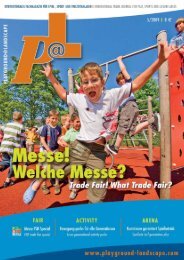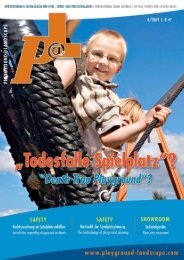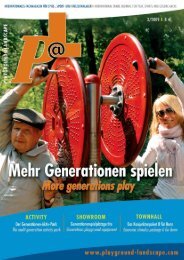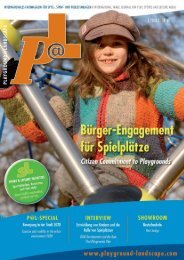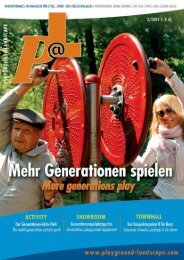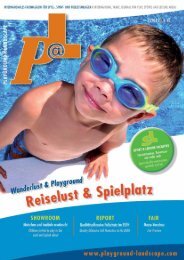Vitalitätstraining für Jung und Alt - Playground@Landscape
Vitalitätstraining für Jung und Alt - Playground@Landscape
Vitalitätstraining für Jung und Alt - Playground@Landscape
Erfolgreiche ePaper selbst erstellen
Machen Sie aus Ihren PDF Publikationen ein blätterbares Flipbook mit unserer einzigartigen Google optimierten e-Paper Software.
Auf der Gr<strong>und</strong>lage der durchschnittlichen Herzfrequenzprofile**<br />
wurde geschätzt, dass die Kinder ungefähr 100 bis 220<br />
kcal (Kalorien) verbrauchten pro 15 Minuten, die sie am<br />
PlayAlive Spielgerät verbrachten. Der Kalorienverbrauch<br />
hielt selbst dann noch an, als sie PlayAlive nicht mehr nutzten,<br />
da ihre Herzfrequenz einige Zeit erhöht blieb.<br />
Dr Jacky Forsyth, Senior Lecturer auf dem Gebiet Exercise<br />
Physiology Sport and Exercise an der Universität Staffordshire,<br />
sagte dazu: „Es wird empfohlen, dass Kinder sich<br />
mindestens 60 Minuten pro Tag mäßig intensiv bis intensiv<br />
bewegen. Daher ist jedes Spielgerät, das die Kinder zu regelmäßiger<br />
körperlicher Bewegung animiert, in hohem Maße<br />
<strong>für</strong> ihre Ges<strong>und</strong>heit <strong>und</strong> ihr Wohlergehen förderlich.“<br />
Am PlayAlive Spielgerät sind verschiedene Spielaktivitäten<br />
<strong>und</strong> Übungen möglich, darunter: aerobe Übungen (gut <strong>für</strong><br />
Herz, Lungen <strong>und</strong> Kreislauf) sowie Übungen zur Förderung<br />
von Beweglichkeit, Gelenkigkeit, Gleichgewichtssinn <strong>und</strong><br />
Koordination (gut <strong>für</strong> die allgemeine Beweglichkeit).<br />
Stuart Wetherell von Wicksteed bemerkte hierzu: „Dies ist<br />
ein echter Schritt nach vorne in Sachen Spielgerätegestaltung,<br />
da PlayAlive tatsächlich durch spannende Herausforderungen<br />
dazu verlockt, sich körperlich anzustrengen.<br />
Kinder wetteifern von Natur aus gerne miteinander <strong>und</strong><br />
dieses aufregende Spielgerät macht einfach Spaß, sorgt<br />
central computer console that allows interactive electronic games to be<br />
played via satellites aro<strong>und</strong> the structure.<br />
Researchers from the University studied children aged 9-11 and test<br />
results revealed that those playing on the PlayAlive equipment were<br />
exercising mostly at between 60-80% of their age-related maximum<br />
heart rate, which equates to moderate to vigorous physical activity.<br />
Based on the average heart rate profiles**, it was estimated that the children<br />
were using approximately 100-220kcal (calories) for each 15 minutes<br />
they spent on the PlayAlive equipment. They continued to expend<br />
further calories after they had finished using PlayAlive as their heart<br />
rates continued to be raised after they had stopped.<br />
Dr Jacky Forsyth, Senior Lecturer in Exercise Physiology Sport and<br />
Exercise at Staffordshire University commented, “The physical activity<br />
recommendation for children is to accumulate at least 60 minutes per<br />
day of moderate to vigorous activity. Therefore any play equipment that<br />
encourages children to exercise regularly will be hugely beneficial to their<br />
health and wellbeing.”<br />
Different types of activity were involved whilst playing on PlayAlive and<br />
included; aerobic activity (good for the heart, lungs and circulation), flex-<br />
<strong>für</strong> Adrenalinschübe <strong>und</strong> lässt das Herz schneller schlagen!<br />
Es kann schwierig sein, die richtige Balance zu finden <strong>und</strong><br />
einen Erholungs- <strong>und</strong> Spielbereich <strong>für</strong> Kinder ab 8 Jahren interessant<br />
<strong>und</strong> ausgewogen zu gestalten, aber das neue Spielgerät<br />
PlayAlive erfüllt wirklich deren Bedürfnis nach etwas,<br />
das “cool” aussieht <strong>und</strong> eine Generation anspricht, die den<br />
ultimativen Nervenkitzel sucht <strong>und</strong> von elektronischen<br />
Spielen fasziniert ist.“<br />
Anmerkungen des Herausgebers:<br />
* Studie, veröffentlicht in der Fachzeitschrift Archives of Disease<br />
in Childhood vom 22. Dezember 2009<br />
** Auf der Gr<strong>und</strong>lage der durchschnittlichen Herzfrequenzprofile<br />
wurde geschätzt, dass die Kinder ungefähr 100 bis 220<br />
kcal (Kalorien) verbrauchten pro 15 Minuten, die sie am<br />
PlayAlive Spielgerät verbrachten. Diese Schätzung des Kalorienverbrauchs<br />
geht von einer durchschnittlichen Körpermasse<br />
(Gewicht in kg) von 32 kg <strong>für</strong> <strong>Jung</strong>en sowie Mädchen (ungefähr<br />
10 Jahre alt) aus, <strong>und</strong> geht ferner davon aus, dass die <strong>Jung</strong>en<br />
<strong>und</strong> Mädchen durchschnittlich fit sind <strong>und</strong> dass der Energieverbrauch<br />
am PlayAlive Spielgerät dem Energieverbrauch beim<br />
Laufen entspricht, obwohl der Kalorienverbrauch vermutlich<br />
abweichen kann, da die Arme eingesetzt werden.<br />
ibility, agility, balance and co-ordination (good for general mobility).<br />
Stuart Wetherell from Wicksteed commented, “This is a real move<br />
forward in terms of play equipment design for as it really encourages<br />
physical exertion through presenting a tantalizing challenge. Kids are<br />
naturally competitive and this should really offer them exciting play that<br />
gets the heart racing!<br />
It can be difficult to get the balance right for a recreation area for children<br />
of 8+ but the new PlayAlive really fulfils their need for something that<br />
looks ‘cool’ and appeals to a thrill-seeking generation that is captivated<br />
by electronic games.”<br />
Editors Notes:<br />
* study published in the Archives of Disease in Childhood Journal on 22nd<br />
December 2009<br />
** Based on the average heart rate profiles, it was estimated that the<br />
children were using approximately 100 to 220 kcal (calories) for the 15minutes<br />
of activity on the PlayAlive equipment. This estimation of calorie<br />
expenditure assumes an average body mass (weight in kg) of 32 kg for<br />
both the boys and girls (approximately 10 years old), that the boys and<br />
girls have an average fitness level, and assumes that the energy expenditure<br />
is similar to that expended during running, although it is likely that,<br />
because the arms are being used, calorie expenditure may differ.<br />
69



